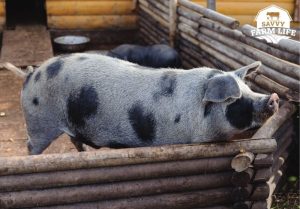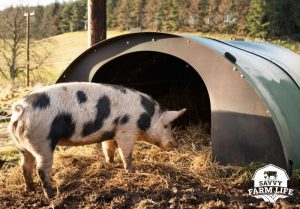
What You Need to Raise Pigs
If you are thinking about getting into pig farming or even raising a couple of pigs for your freezer, you will need to know about the equipment to have on hand. While pigs are hardy and relatively easy to care for, there is still a list of necessities to keep in the barn before bringing your first pigs home.
So what is it that pigs need? What is on their list of necessities? You will need to have several pig necessities on hand before your pigs arrive, and there are also items that, while not absolutely necessary, will make your life as a pig owner a lot easier. These items include:
- Fencing
- Shelter
- Bedding
- Feeding devices (and feed)
- Watering device
- Cleaning and mucking equipment
- Pig boards
- First Aid kit
- Heat lamps, if breeding
This supplies list may seem vague if you’re new to raising pigs. To get a complete breakdown of these items and the quality you’ll need to raise pigs, keep reading!
Pig Housing Supplies
If you are bringing pigs home, you will need a secure spot for them to stay – this includes both fencing and a shelter.
Pig Fencing
Your first pigs will likely be young feeders, often sold when weaned and have reached 40 or 50 pounds. You can get away with simple T posts and hog panel fencing with these young pigs. These are widely available at farm supply stores and home improvement stores and are simple to erect.
Pigs grow rapidly, however, and soon you will have a 200-pound pig full of muscle that is pushing his way right through those hog panels. You will need stronger fences at this stage, and the most economical way to attain this is through electric fencing. I recommend using live wire as a secure fencing option for mature pigs and as a means of moving fences or creating new pens for isolating or pregnant pigs.
Pig Shelter
Pig farmers may choose to keep their pigs in paddocks, barns, pasture, or foraging in the woods. Regardless of your pigs’ environment, you will need to provide an accessible shelter they can use to escape the wind, rain, and sun. Pigs have little hair and are highly susceptible to sunburn. You will want protection, such as a shed, large enough for all of your pigs to use and strong enough so that they will not knock it down. Make sure to pick up bedding for your pigs – you can use wood shavings or straw in the shelter. Not only will this provide insulation for the pigs, but it keeps the shelter smelling fresh(er) and makes it easier to muck out.
To learn how much it costs to build a pig shelter, visit my article How Much it Costs to Raise Pigs: Complete Expense Guide.
Pig Feeding and Watering Supplies
 If you’re raising your pigs for meat, you can choose to free-feed your pigs. While you can use rubber feed pans, you may instead invest in a large trough or an automatic feeding device (such as a gravity feeder) to hold at least a few days’ worths of feed. If the feeders are located outside the pig’s shelter, make sure that they have lids that will close automatically to protect the feed from moisture. Of course, make sure that you pick up a few bags of commercial pig feed before bringing the pigs home as well.
If you’re raising your pigs for meat, you can choose to free-feed your pigs. While you can use rubber feed pans, you may instead invest in a large trough or an automatic feeding device (such as a gravity feeder) to hold at least a few days’ worths of feed. If the feeders are located outside the pig’s shelter, make sure that they have lids that will close automatically to protect the feed from moisture. Of course, make sure that you pick up a few bags of commercial pig feed before bringing the pigs home as well.
Pigs are both strong and curious, so while you can use rubber pans to hold water in a pinch, after finding it tipped over multiple times, you will probably want to invest in something sturdier. Nipple or cup watering devices can be attached to either a hose bib or a water barrel. These cannot be tipped over and provide unlimited access to clean water. Not only are these automatic watering devices often healthier for the pigs, but they are also much more convenient for you.
Pig Cleaning Supplies
Pigs produce a lot of manure; in fact, a mature pig will easily produce 10 pounds of waste per day. When it comes to manure, pigs are particularly odorous compared to other livestock, and you will need to clean the environment regularly. You can compost the manure or take it off-site. Pig manure is not equal to horse or cow manure – pigs are omnivores, and their waste is full of potentially harmful bacteria. For this reason, you will not want to add it directly to your garden. Make sure that you compost it thoroughly before using it as fertilizer.
For this chore, you will want to purchase a good pair of rubber boots for yourself if you don’t already have some lying around (and no need to buy the designer brands – these will get caked in manure almost immediately).
Regardless of whether the manure is going in the compost pile or off-site, you will also need to have a wheelbarrow to cart it in and out of the pen – this wheelbarrow will fill up quickly, so it is best to purchase one that is meant for mucking out livestock pens. You will also need a muck shovel or a pitchfork.
You may also find a pressure washer useful if your pigs are on concrete. Manure can stick to the concrete, and a hose is often insufficient to remove the waste. Pressure washers can be used for a wide variety of tasks around the home and garden, so if you don’t already own one, you might find a neighbor or friend willing to lend one to you.
There are things you can do to decrease the amount of odor coming from a pig pen. To learn more, visit my article Do Pigs Smell Bad? Pig Odor Guide.
Pig Medical Supplies
Pigs are hardy animals, usually healthy and strong, without human intervention. But it is ideal to have a small first aid kit on hand just in case it is needed – this is especially true if you are breeding your pigs. A simple pig first-aid kit might include antimicrobial spray for wound cleaning and healing, dewormers for breeding sows and piglets, and a broad-spectrum antibiotic. While you can likely purchase these items online, it might serve you better to pick them up at your local feed store. This is where you can often find advice on the specifics related to diseases and parasites prevalent in your region.
Pig Management Supplies
You will occasionally need to move one of your pigs for several reasons. You may need to isolate a sow from her piglets, check for an injury, administer medication, or transport a hog for processing. Pigs are robust and won’t accept a halter or lead. For moving pigs, you will find a pig board essential.
Pig boards are large, plastic boards with a handle at the top – when used correctly, you can use them to “herd” one or more pigs to a desired location or direction. You place the pig board next to the pig’s head, in the opposite direction you would like him to proceed. He will turn to avoid the board and will be on his way. If you don’t have a pig board on hand, you can also use a piece of plywood – while this works just as well to move pigs, it will be more cumbersome than a plastic pig board.
It is nice to have more than one pig board on hand for the situations where you need help. If there is more than one “keeper” of your herd, each should have its board. While one board is better than no boards when moving pigs, two panels are even better.
Pig Farrowing (Birthing) Supplies
If you are breeding pigs, you will need a few additional supplies. A few days before farrowing (giving birth), your sow will start nesting and looking for an isolated area. You will want to have a safe, clean farrowing spot isolated from the rest of the pigs. Fill the site with plenty of clean straw so that your sow can arrange her nest as she sees fit.
You can also set up a heat lamp during farrowing and for the first few days afterward. Piglets are susceptible to cold, and studies have shown that placing a heat lamp near the rear of a farrowing sow can decrease piglet mortality rates. The theory is that if the heat lamp is near the sow’s rear, the piglet will be exposed to the additional warmth as he is being born. Take caution when hanging the heat lamps – straw is highly flammable, and you will want to secure the heat lamps appropriately to prevent a fire.
With The Right Supplies, You Should Have Healthy Pigs
Pigs are relatively easy to care for compared to other farm animals and pets. After all, you don’t have to shear them as you do sheep or trim hooves as frequently as other livestock. They are generally healthy and resistant to disease and parasites. They can eat almost anything without experiencing digestive upset and costly veterinary bills. You should easily have a healthy, happy herd of pigs with the necessary supplies and equipment.
Before you take the plunge into owning pigs, it’s important to know both the pros and cons that come with raising these animals. For a complete breakdown, visit my article Top Pros and Cons of Owning and Raising Pigs.
